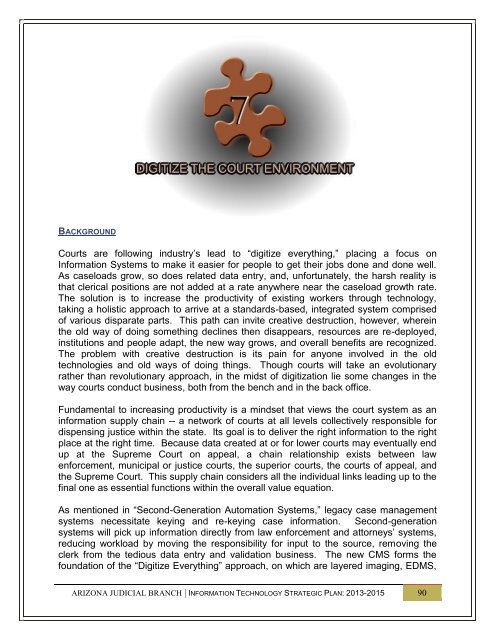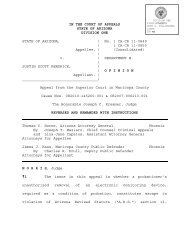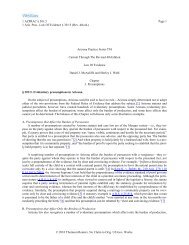Print Version - Arizona Judicial Department
Print Version - Arizona Judicial Department
Print Version - Arizona Judicial Department
Create successful ePaper yourself
Turn your PDF publications into a flip-book with our unique Google optimized e-Paper software.
BACKGROUND<br />
Courts are following industry’s lead to “digitize everything,” placing a focus on<br />
Information Systems to make it easier for people to get their jobs done and done well.<br />
As caseloads grow, so does related data entry, and, unfortunately, the harsh reality is<br />
that clerical positions are not added at a rate anywhere near the caseload growth rate.<br />
The solution is to increase the productivity of existing workers through technology,<br />
taking a holistic approach to arrive at a standards-based, integrated system comprised<br />
of various disparate parts. This path can invite creative destruction, however, wherein<br />
the old way of doing something declines then disappears, resources are re-deployed,<br />
institutions and people adapt, the new way grows, and overall benefits are recognized.<br />
The problem with creative destruction is its pain for anyone involved in the old<br />
technologies and old ways of doing things. Though courts will take an evolutionary<br />
rather than revolutionary approach, in the midst of digitization lie some changes in the<br />
way courts conduct business, both from the bench and in the back office.<br />
Fundamental to increasing productivity is a mindset that views the court system as an<br />
information supply chain -- a network of courts at all levels collectively responsible for<br />
dispensing justice within the state. Its goal is to deliver the right information to the right<br />
place at the right time. Because data created at or for lower courts may eventually end<br />
up at the Supreme Court on appeal, a chain relationship exists between law<br />
enforcement, municipal or justice courts, the superior courts, the courts of appeal, and<br />
the Supreme Court. This supply chain considers all the individual links leading up to the<br />
final one as essential functions within the overall value equation.<br />
As mentioned in “Second-Generation Automation Systems,” legacy case management<br />
systems necessitate keying and re-keying case information. Second-generation<br />
systems will pick up information directly from law enforcement and attorneys’ systems,<br />
reducing workload by moving the responsibility for input to the source, removing the<br />
clerk from the tedious data entry and validation business. The new CMS forms the<br />
foundation of the “Digitize Everything” approach, on which are layered imaging, EDMS,<br />
ARIZONA JUDICIAL BRANCH | INFORMATION TECHNOLOGY STRATEGIC PLAN: 2013-2015 90

















